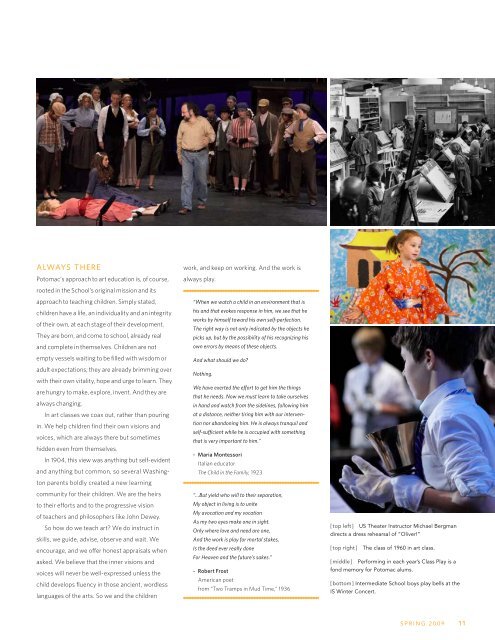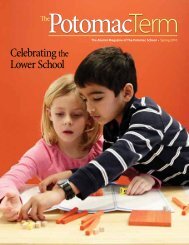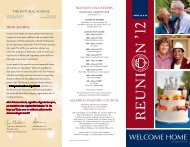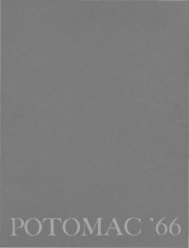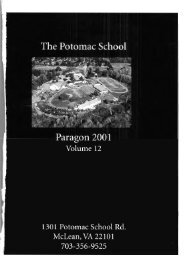Spring 2009 Potomac Term - Potomac School
Spring 2009 Potomac Term - Potomac School
Spring 2009 Potomac Term - Potomac School
You also want an ePaper? Increase the reach of your titles
YUMPU automatically turns print PDFs into web optimized ePapers that Google loves.
Always There<br />
<strong>Potomac</strong>’s approach to art education is, of course,<br />
rooted in the <strong>School</strong>’s original mission and its<br />
approach to teaching children. Simply stated,<br />
children have a life, an individuality and an integrity<br />
of their own, at each stage of their development.<br />
They are born, and come to school, already real<br />
and complete in themselves. Children are not<br />
empty vessels waiting to be filled with wisdom or<br />
adult expectations; they are already brimming over<br />
with their own vitality, hope and urge to learn. They<br />
are hungry to make, explore, invent. And they are<br />
always changing.<br />
In art classes we coax out, rather than pouring<br />
in. We help children find their own visions and<br />
voices, which are always there but sometimes<br />
hidden even from themselves.<br />
In 1904, this view was anything but self-evident<br />
and anything but common, so several Washington<br />
parents boldly created a new learning<br />
community for their children. We are the heirs<br />
to their efforts and to the progressive vision<br />
of teachers and philosophers like John Dewey.<br />
So how do we teach art? We do instruct in<br />
skills, we guide, advise, observe and wait. We<br />
encourage, and we offer honest appraisals when<br />
asked. We believe that the inner visions and<br />
voices will never be well-expressed unless the<br />
child develops fluency in those ancient, wordless<br />
languages of the arts. So we and the children<br />
work, and keep on working. And the work is<br />
always play.<br />
“When we watch a child in an environment that is<br />
his and that evokes response in him, we see that he<br />
works by himself toward his own self-perfection.<br />
The right way is not only indicated by the objects he<br />
picks up, but by the possibility of his recognizing his<br />
own errors by means of these objects.<br />
And what should we do?<br />
Nothing.<br />
We have exerted the effort to get him the things<br />
that he needs. Now we must learn to take ourselves<br />
in hand and watch from the sidelines, following him<br />
at a distance, neither tiring him with our intervention<br />
nor abandoning him. He is always tranquil and<br />
self-sufficient while he is occupied with something<br />
that is very important to him.”<br />
- Maria Montessori<br />
Italian educator<br />
The Child in the Family, 1923<br />
“…But yield who will to their separation,<br />
My object in living is to unite<br />
My avocation and my vocation<br />
As my two eyes make one in sight.<br />
Only where love and need are one,<br />
And the work is play for mortal stakes,<br />
Is the deed ever really done<br />
For Heaven and the future’s sakes.”<br />
- Robert Frost<br />
American poet<br />
from “Two Tramps in Mud Time,” 1936<br />
[ top left ] US Theater Instructor Michael Bergman<br />
directs a dress rehearsal of “Oliver!”<br />
[ top right ] The class of 1960 in art class.<br />
[ middle ] Performing in each year’s Class Play is a<br />
fond memory for <strong>Potomac</strong> alums.<br />
[ bottom ] Intermediate <strong>School</strong> boys play bells at the<br />
IS Winter Concert.<br />
<strong>Spring</strong> <strong>2009</strong> 11


